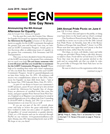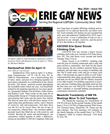New Analyses Offer Clearer Picture of Where to Target HIV Prevention and Care Efforts to reach Gay and Bisexual Men at Greatest Need
HIV Infection among Gay and Bisexual Men Especially High in the South
In the United States, the burden of HIV is disproportionately high for men who have sex with men (MSM), who account for approximately two-thirds of all new diagnoses each year. Results from a new study estimating rates of HIV prevalence (number of people living with an HIV diagnosis) among MSM at local levels highlight areas where gay and bisexual men are at greatest risk for HIV infection. Focusing on these areas will allow health departments and community-based organizations to provide HIV prevention and care resources to MSM who need them most.
A new report in JMIR Public Health and Surveillance, authored by researchers at Emory University's Rollins School of Public Health, provides state, city and county estimates of the rate of MSM living with HIV. According to the report, HIV prevalence among MSM in 2012 was 15 percent (i.e., 15 in 100 MSM were living with HIV infection), but rates vary dramatically by geographic area.
"We know from surveillance data that MSM represent a high percentage of people living with HIV and annual HIV diagnoses, and prior studies have shown that rates of HIV among MSM are dramatically higher than among other populations. However, our analyses are the first to present HIV rates among MSM broken down by states, counties, and metropolitan statistical areas," says research team lead, Eli Rosenberg, PhD, assistant professor of epidemiology at Rollins School of Public Health. "These refined results are an additional tool for regional and local public health action and provide further evidence for the need to prioritize HIV prevention efforts for MSM and particularly for MSM living in the South."
Results indicate:
- There were six states where more than 15 percent of MSM were living with diagnosed HIV infection in 2012, all of which were in the US South
- Of the 25 metropolitan statistical areas (MSAs) with the highest levels of MSM living with an HIV diagnosis, 21 were located in southern states
- Estimates showed in 2012, at least one in four MSM were diagnosed with HIV in the following MSAs: Jackson, MS; Columbia, SC; El Paso, TX; Augusta, GA; Baton Rouge, LA
"By pinpointing where HIV strikes the hardest, we have a key piece of the puzzle highlighting the largest disparities within states and the South," says Dr. Jonathan Mermin, director of CDC's National Center for HIV/AIDS, Viral Hepatitis, STD, and TB Prevention. "We hope these data empower local public health officials, community-based organizations and everyone fighting HIV to bring resources to the gay and bisexual men who need them the most."
The analyses were funded in part by a CDC cooperative agreement with the Rollins School of Public Health aimed at creating and adapting models to improve public health decision making and effectiveness. HIV prevalence estimates were calculated by dividing CDC HIV surveillance data from AIDSVu.org and CDC publications by recently published MSM population estimates from a team led by Jeremy A. Grey, PhD, epidemiologist at the Rollins School of Public Health.
The complete report being published today is available here: http://publichealth.jmir.org/2016/1/e22/




